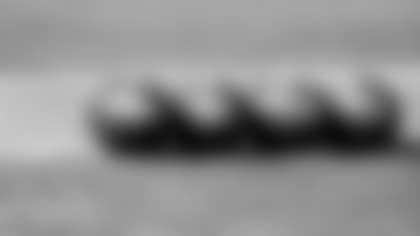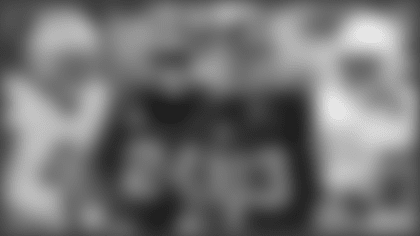In the Nest is an editorial series uncovering player personalities and the people who help the organization's gears turn smoothly off the gridiron.
This installment journeys into what a recovery day entails and the science and technology behind it.
Story by Amna Subhan
Motion is lotion.
These three words sum up the recovery mindset after playing an NFL football game. As much as anyone would want to rest the day after playing professional football and enduring blows similar to a car crash, it's imperative players get moving as soon as possible.
"There's a fine line. You got to rest, let your body chill," inside linebacker Nate Landman, "and then also motion is lotion."
There's a critical time window to restore blood flow and regain range of motion, Falcons director of player performance John Griffin said.
The Falcons deploy several methods to get players moving. They'll strap on blood flow restriction bands and engage in a mobility circuit consisting of slow-pace or "flush" runs, weight lifting, biking, static stretches and movement in cold tubs — anything to lessen inflammation and halt stiffness in muscles.
The objective for Griffin and his performance team is to keep players available and prevent injury. Movement on recovery Mondays is the first step in that process.
"The most common thing for most people to do after going through something vigorous like that, maybe running a marathon, being in an amateur fight, is probably, 'I just want to sleep the next day. I want to do nothing,'" Griffin said. "But we know we have another game coming up next week, and we got to practice on Wednesday, and we got two days."

Sometimes, they have even less time to recover when playing on national television.
The Falcons have played in four prime-time games this season, three of which occurred in a four-week span. Most recently, the Falcons played on "Monday Night Football" against the Las Vegas Raiders in Week 15.
The team plane departed Atlanta Sunday evening and landed in Las Vegas around 10:30 p.m. ET, in order to keep guys on a similar schedule despite the three-hour time change. The later departure was done with the intention of not disrupting players' circadian rhythms. They left when the sun was up and arrived when it was setting over the Mojave Desert.
Player education is an important tool in recovery, so Griffin advised guys to stay awake on the way to Las Vegas no matter their bedtimes. He recommended they watch movies or play games to pass the time. Conversely, he urged players to sleep on the plane ride home, which arrived just before dawn.
When playing night games sleep is sometimes the most important part of recovery, and sometimes the biggest challenge as well. That's why Tuesday resumed as a typical player-off after the Monday night win instead of mirroring a usual recovery day.
This is when that fine line leans more toward rest. There are no meetings or anything to dissuade the athletes from getting as much sleep as possible. However, Griffin still recommends players move, allow blood to flow and get some sun exposure. Barring injury, any lingering soreness can be addressed before the normal practice week begins Wednesday.
Injuries are an unpredictable but oftentimes inevitable factor of NFL football, hence why recovery and the vast models that are constantly evolving are so important. Even, if it's sometimes painful.
Part of Landman's recovery routine is Active Release Technique or ART administered by a chiropractor. While the deep massage is "brutal," it's nothing out of the ordinary for NFL athletes.
"I know that for most people a quad contusion, or an AC sprain, or a bruised rib, would probably be very serious, very critical, and probably affect their entire week. For these guys, it's probably pretty normal," Griffin said. "They're pretty functional with it. It hurts for a couple days. They get up, they move, they get a little bit of treatment, and then they're playing through it. They're practicing through it. They're lifting through it. So, I think just it's a mindset, and it's a lifestyle of just something you've become accustomed to experiencing playing football."
"For most people a quad contusion, or an AC sprain, or a bruised rib, would probably be very serious, very critical, and probably affect their entire week. For these guys, it's probably pretty normal." - John Griffin
Losing a Monday recovery day or playing on a short week is also something NFL players are used to. However, it means Griffin and his staff have to get creative with adjusting routines. While Sunday night games can throw off the recovery clock for the week ahead, preparing for a Thursday night game on a short week is often the most tricky.
So, when the Falcons geared up to play "Thursday Night Football" earlier this season, the recovery began as soon as possible. After the Falcons beat the New Orleans Saints 26-24 in Week 4, the locker room became a recovery room. Griffin said about 95% of players stayed back long after speeches, showers and media availability had wrapped to start some sort of recovery. They brought in bikes, blood flow restriction units, vitamin packs and more to simulate a Monday recovery day.
The extra efforts paid dividends in Week 5 on Thursday night. The Falcons played a longer game than expected in a 36-30 overtime win against the Tampa Bay Buccaneers.
Getting ahead of the recovery process was something Griffin learned when he was with the Los Angeles Rams. Griffin and Falcons head coach Raheem Morris both began their tenure with the Rams in 2021 — Morris as defensive coordinator, Griffin as assistant strength and conditioning coach and, eventually, associate director of strength and conditioning.
Both men took a lot from their time under Sean McVay. McVay would often consult with the player performance staff to coordinate whether the team needed to substitute a padded practice with a walk-through. The Falcons held a "walk-through Wednesday" in back-to-back weeks based on Griffin's recommendation in Weeks 10 and 11.
The Falcons ruled out eight players in Week 11 against the Denver Broncos; it was one of their most injury-riddled games of the season.
"It's really cool. Those guys have all the science behind it. We kind of just fall in line and say, 'Okay, that's what we're doing today,'" Falcons offensive coordinator Zac Robinson said. "But seeing how that worked in L.A. and how fresh guys could be on Sundays dating back to my first year in 2019, I didn't know that it was allowed to not practice on a Wednesday. I thought you just had to be smashing heads all the time."
It's all based on data the player performance staff compiles.
"The guys will have a chip in their shirt or their jersey. It just monitors yardage, how fast you run, how many yards you run, how many times you start, how many times you stop," Griffin said. "Anything you want to know on a guy, there's thousands of metrics you can look at."
More importantly, it's how you interpret the numbers. The data is all loaded into Microsoft Power BI — an interactive data visualization software — and Griffin has the challenge of figuring out what to do with it all. From there, they can get ahead of potential injuries. The numbers can determine if a particular player or position group is fatigued. Then they can make assessments to the coaching staff.
"It helps you make all the schedules, and it helps you be more confident in telling coach, 'I think it'd be really good if we did a walk-through today,' and you have some objective data to back it up," Griffin said. "Rather than just subjectively looking at guys and saying like, 'Hey, I feel like they're banged up.'"

Technology like the chip plays a huge part in players' recovery routines. The Falcons have multiple different resources at their disposal from Normatec boots to whole spaces equipped with cutting-edge technology. Most recently, they added a red light recovery room as part of the training facility expansion over the offseason.
The room, which is lined with red-light panels, is a technology many years in the making. Red light therapy, or photobiomodulation, helps regenerate damaged tissue.
"That's what we're searching [for], especially because these guys run so much at such high intensities," Griffin said. "How can we get the tissue to turnover week to week?"
Landman has one portable red light device at his house. Fellow inside linebacker JD Bertrand, who Landman says "loves his recovery," takes it a step further with a red-light-therapy sauna, which helps flush lactic acid and promote tissue turnover. Bertrand, an Atlanta native, has a "recovery clinic" at his parent's house. This way he can spend time with family after the game but still get ahead of recovery for the next day.
Rookies like Bertrand aren't the only ones who have taken up red light therapy. Seasoned veterans like offensive tackle Jake Matthews have done so as well. Matthews, who is in his 11th season, has added it to his iron-man routine, which has helped Matthews set a franchise record with 155 consecutive starts. The former Pro Bowler is slightly skeptical but hopeful about the effects.
"This specific LED light will send a heat wave that'll help your body heal," Matthews said. "That's very odd to me, but, hey ... I've been doing it pretty regularly. I feel pretty good. Feel like I'm recovering quicker, so I'm gonna keep doing it."
This season, Matthews' consecutive start record has extended to 175, the longest active streak in the NFL after Week 15.
Cornerback Antonio Hamilton Sr. heard inklings of red light therapy when he was a rookie in 2016 and saw it develop into an integral part of teammates' routines across different franchises. Dr. Cleber Ferraresi, a professor at the Federal University of São Carlos in Brazil has been studying photobiomodulation for more than a decade. He co-authored the study, "Photobiomodulation in human muscle tissue: an advantage in sports performance?" in 2016 as a student at Harvard Medical School. The trial sought to discover if infrared light had an effect on athletes and found promising results. He sees this as only the beginning of red light therapy in sports.
"In my opinion, photobiomodulation will be used for many teams," Ferraresi told AtlantaFalcons.com. "Not only on the muscles but [also] the blood, on the head, for the brain. I think in the next two, three years it'll be a reality. It'll be a common treatment in sports teams."
Ferraresi said ongoing clinical trials are testing the effects of treating concussions with good results thus far. While red light therapy is perhaps newer technology that is still developing, hyperbaric chambers may be even more popular around the locker room.
The chamber, like red light therapy, is supposed to help speed up recovery. It aids in healing wounds and reducing fatigue.
Several Falcons players including Bijan Robinson, Kyle Pitts, Darnell Mooney and Kaden Elliss have the spaceship-looking chamber device in their homes.

Staying consistent with any of these modulations is the key to seeing results. Pitts used a hyperbaric chamber after his surgery to repair both MCL and PCL ligaments. The tight end said he felt like it had an impact on this rehab process and still includes it in his routine. Rookie outside linebacker Bralen Trice, who's recovering from an ACL surgery in August has added it to his process as well.
Using hyperbaric chambers is a heavy time commitment, a typical session typically lasts two hours. Some read to pass the time. Robinson often takes a nap. Elliss sometimes brings his kids along with him to hang out.
How players recover or incorporate technology is never uniform, but the end goal is always the same: being ready to go on game day.
"I think so much of it is also personalized," Ellis said. "Obviously, there's some things that are pretty science-based, so it'd probably work for everybody, but there's a lot of things that you just got to know [about] your own body. I've been around a lot of players [and] their routine was completely different. I've been around players that lifted the heaviest they did all year, all week, would be the day after a game. I knew some players that were All-Pro, Pro Bowl, that didn't touch a weight until two days after. So, I think a lot of it is consistency, and knowing your body, what works for you, and rolling with that."















